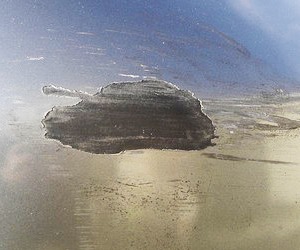
In this post, I will show you how to repair deep bumper scratches on a Porsche Cayenne. As you can see from the photo above, scratches went through the clear coat layers and paint layers but didn’t damage the primer.
Although the damaged area looks small, you will need to spray paint it to get an even coverage. This type of repair can cost anywhere from $300-$500 at the body shop and you will be without the car for a few days. You can do the same repair yourself and save hundreds of dollars.
This project will take you a few hours to complete and can be done over the weekend. The key to success is patience. Make sure to take your time doing each step the right way instead of rushing it.
The step-by-step instructions below include a video, photos, and comments for each step. I don’t recommend using cheap products, since they can compromise the repair. My goal is to save you money, but still, give you good-quality products. The process might be a little different if you are using different products. Don’t forget to read the instructions for each product.
Items You’ll Need:
- Assorted Wet/Dry Sandpaper – This pack includes 5 sheets of assorted sandpaper (1 sheet each of 180, 320, 600, 1000, and 1,500) and can be used for sanding primer, clear coats, and automotive paints.
- Primer (aerosol spray) – Gray primer works the best for this repair.
- Touch-Up Paint (aerosol spray) – Order paint by clicking on the link and selecting your color.
- Clear Coat (aerosol spray) – I used it to protect the paint and give it a glossy finish.
- Auto masking tape and Old Newspapers
- Prep solvent – It removes oils, road grease, dirt, car wax, and other surface contaminants and also improves adhesion to the surface.
- Meguiar’s Ultimate Compound – You can use any rubbing compound you like, just make sure it is clear coat safe. Meguiar’s Ultimate Compound is the best car scratch remover I’ve ever tried. It removes light-to-deep clear coat scratches, swirl marks, stains, and heavy oxidation in just a few minutes. It’s clear coat safe and inexpensive.
Optional Items:
- Aerosol Spray Trigger
– Very inexpensive item that can turn a spray aerosol can into a spray gun. Using this trigger will make it easier to apply the paint and clear coat.
- Meguiar’s Ultimate Polish – Use your favorite polishing compound. I like Meguiar’s Ultimate Polish because it uses diminishing abrasive technology, meaning the tiny abrasives break down gradually as you rub. The paint color will look bolder and brighter with a smooth, sleek shine. It is high quality, inexpensive, long-lasting, and clear coat-safe.
- Meguiar’s Tech Wax – Use your favorite wax. I like Meguiar’s NXT Generation Tech Wax. This product is amazing because not only does it give the deepest and clearest shine you’ve ever seen, but it also acts as a paint sealer giving your car long-lasting protection.
- Microfiber cloth – The new microfiber technology is widely used in the car industry to avoid clear coat scratches that regular towels leave. It is great for drying the car and cleaning off residue.
- Applicator Pads – These pads are used to apply rubbing compound, polish, and wax.
- Dual Action Sander/Polisher – I found a nice beginner polisher on Amazon for a reasonable price that will give you amazing results. There are a lot of professional polishers, but they cost over $200. This Black & Decker polisher got great customer reviews.
- Tack Rag
– Sticky material for removing dust.
- Respirator, Gloves, Goggles – When working with toxic products, don’t forget about personal safety.
Step 1: Get the Paint
First, buy all the products including the touch-up paint. To get the right paint, you need to know the color code for your car, which can be found somewhere inside of your car. Finding that code can sometimes be challenging.
Here is an article I wrote on where to find car paint color code. After you know the color code, order the touch-up paint. For this repair, you will need an aerosol spray can. While you are purchasing a touch-up paint it is a good idea to get a touch-up paint pen to keep in your car for repairing small scratches and chips.
Step 2: Personal Safety
Although a lot of people don’t use any protection, I do recommend using goggles, masks, and gloves when working with paint products. These simple items don’t cost much but can protect you from injuries. It is also important to do all the spraying in a well-ventilated space.
Step 3: Preparing the Area
The key to a successful paint job is a well-prepared surface. You should spend 70% of your time on area preparation before spray painting and 30% on applying paint and a clear coat.
Check for the rust first. If you had scratches for a while, it might have some rust. Rust can be easily removed with rust remover. Before starting the repair job, clean the area with warm water and a few drops of dish soap.
Follow it with prep solvent. Spray the surface with prep solvent and wipe it with a clean microfiber towel. This will ensure that the area is free of oil, wax, dirt, and other contaminants.
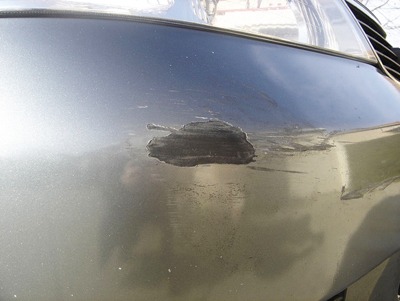
Step 4: Masking
Mask the area using auto masking tape and old newspapers. Don’t use duct tape, it will leave a sticky residue that is hard to remove. You want to leave some space around scratches for better blending.
You can use plastic instead of newspapers. Masking will prevent overspray.
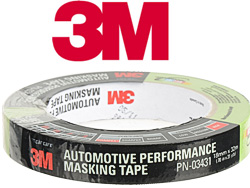
Step 5: Sanding
In this step, you want to even out the surface so that when you touch it with your fingers you can’t tell where the damage ends and the paint begins. Sand it with wet/dry 600 grit sandpaper.
In the video, the guy is dry sanding. I like wet sanding more. It doesn’t really matter. Do whatever works for you.
For wet sanding, soak sandpaper in cold water for 10 min. Add a few drops of dish soap to make it more slippery.
Wet sand the area that might get some touch-up paint and clear coat with wet/dry 1,500 grit sandpaper. Make sure to use a lot of water.
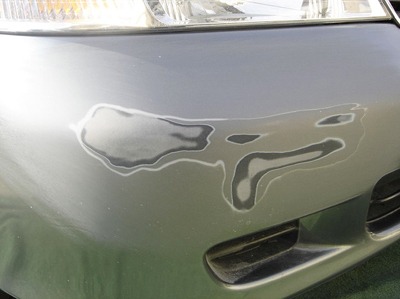
Step 6: Prep solvent
After sanding is done, clean the area with prep solvent to get rid of the dust. Spray the prep solvent and wipe it off with a clean microfiber cloth.
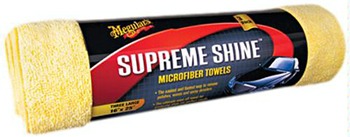
Step 7: Apply Primer
The primer comes in different colors. The closer the color of the primer to the color of your car, the fewer paint coats you will need to apply to cover it. For this repair, gray primer works best. Spray the area with primer. Don’t worry, overspray can be easily removed in the next step.
Read the instructions on the primer. Shake the can. Hold the can 15 inches away from the surface and spray in even strokes. Three coats should be enough. Allow each layer at least 10 min drying time.
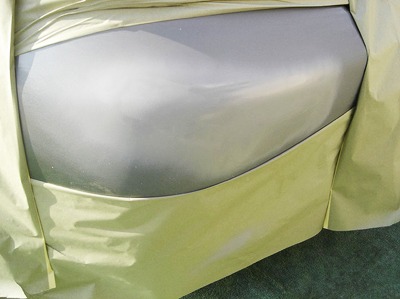
Step 8: Sand Primer
Wait 30 min for the primer to dry. Then, sand it with wet/dry 600-grit sandpaper. Follow it with 1,000 grit for a smooth result. In this step, you can remove the primer overspray. After sanding, the surface should be smooth. Remove the dust with a tack rag and dry the area.
Tip: Wrap sandpaper around a sponge to avoid fingerprints.
Step 9: Apply Touch-Up Paint
Now it is time to apply the touch-up paint. Test the paint in a hidden spot first to make sure the color matches. Read instructions on the paint. For better control and even coverage, use an aerosol spray can trigger.
It is a plastic trigger that easily slides on top of the pray can turning it into a spray gun. They are not using it for the paint application in this video, but it does help a lot.
Tree layers of paint should be enough to cover the primer. Give each layer at least 10 min of drying time. To blend in the new paint with the old one, spray each layer a little farther from the repair area.
This method is called “feathering”. If you see dust on one of the layers, you can gently remove it by using a tack rag.
Step 12: Apply Clear Coat
After the paint application, the area should look dull. To add shine, we need to spray it with a clear coat. Wait for 30 min for the paint to dry before applying a clear coat. Read the instructions for the clear coat.
Shake the can. Hold the can 10-12 inches away from the surface and spray in even strokes covering surrounding areas. 3-4 coats should be enough. Give each coat 10 min drying time.
As you can see, they are using an aerosol spray that can trigger the clear coat application. It turned a clear coat spray can into a spray gun. I recommend getting it. It really helps the coverage and only costs a few dollars. After the clear coat is dry, remove the mask.
Note: Clear coat overspray, dust, or orange peel, can be removed by sanding it with wet/dry 1,500 grit sandpaper.
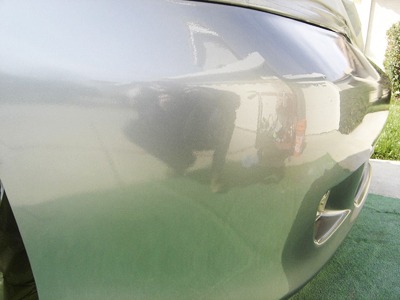
Step 13: Rubbing Compound
The r rubbing compound is used to even out imperfections and to bring out the color of the paint. Wait one day before applying the rubbing compound. You can apply it by hand or with a polisher. Place a small amount of compound into the application pad and rub it by using a circular motion.
Step 14: Polishing Compound
Polishing your car will give it a showroom shine. It can be done by hand or Dual Action Polisher. Apply a small amount of polishing compound onto to foam application pad and rub the surface until it is dry. Remove residue with a clean microfiber towel.
Step 15: Wax
Use any wax you like. Wait for one month before waxing.
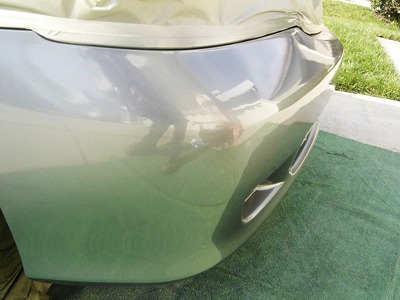
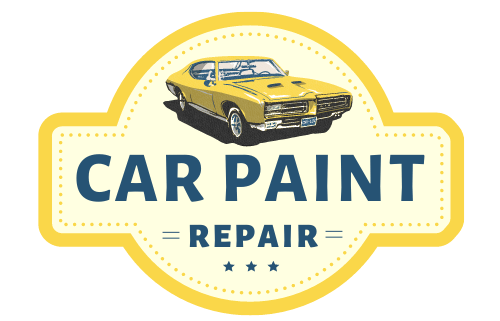

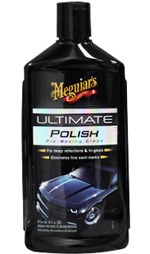
What is the best technique to fether/blend paint in to the surrounding body to make it look nice?
Where can i get a spray paint.